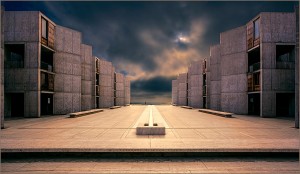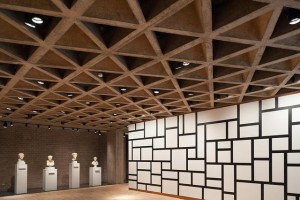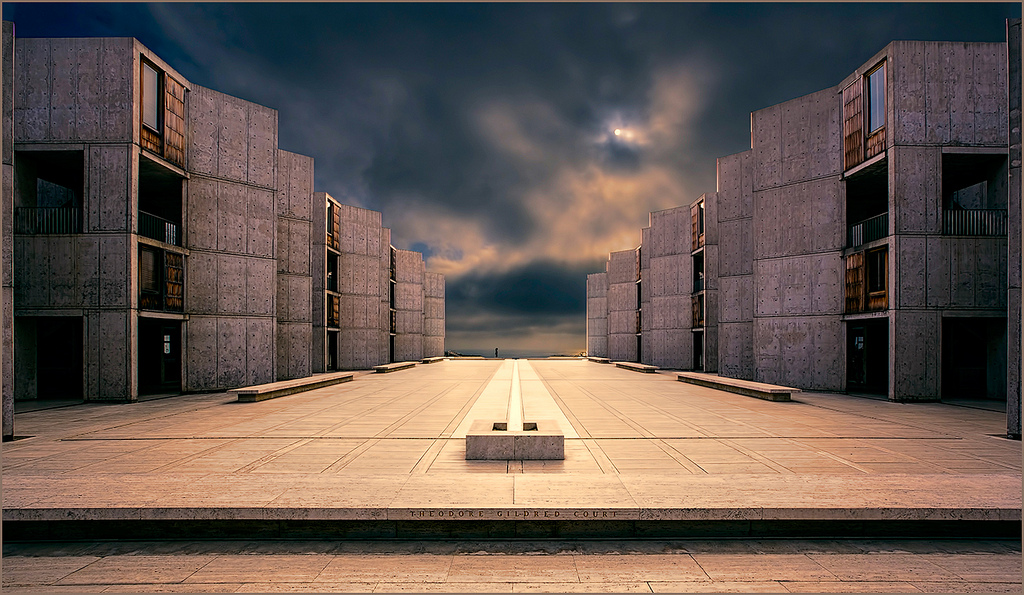Louis Kahn was a highly important modern architect in the post-World War II United States. Based in Philadelpia and known for his monumental and brutalist style while highlighting the materials involved in a building’s construction, he rightfully deserves a place among the 20th century’s most important architects. Two of Kahn’s buildings exemplify his techniques and illustrate why he is so vital to modern architectural history: the Salk Institute and the Yale University Art Gallery.
The Salk Institute, located in La Jolla, California and built from 1959 through 1965, possesses a design which is brutalist in style but intelligent in its use of material and space. Constructed from concrete, wood, and travertine, the complex reflects both its purpose as a site for collective scientific discovery and its designer’s penchant for monumental forms.1 The complex, meant as a site for research and experimentation, expresses the collegial nature of science through its open laboratory spaces and communal design. Kahn clearly understood the Institute’s purpose as a “modern monastery,” and designed the building to accommodate these intentions.2 The two main buildings which comprise the Institute are symmetrical and austere on the exterior, devoid any ornamentation aside from the building materials. Between these buildings lies a court split in the center by a thin stream leading toward the ocean.3 This design is shown in Figure 1, which illustrates the spatial relationships between the different parts of the complex. The combination of court, stream, brutal design, and expression of materials create a colossal appearance to the Institute and illustrates the monumental forms that modern architecture assumed in the United States following World War II. Kahn’s designs, particularly those of the Salk Institute, reflect these forms.

In Kahn’s design for the Yale University Art Gallery, he constructs a building which features many aspects of conventional modern design, yet also possesses several unique features which break with the modern tradition. Like several other modern designs, the Art Gallery features a rectangular main volume with sheet windows on several sides. The materials used are similar as well; glass, brick, and steel feature heavily, and the building makes no attempt to conceal them.4

However, Kahn is unique in the exact way he uses these materials, as well as how he designs the building’s volume. Entire exterior walls are made up of brick and concrete; these walls firmly express their materiality through their unadorned presence; the brick exterior also serves to partially obfuscate the internal structure and axiality of the building.5 The interior of the Gallery also diverges from more contemporary use of space and texture through an intense expression of brute materiality and shape: Khan relied “on the manipulation of surface as the ultimate agent for the revelation of light, space and support,” rather than on the building’s internal frame.6 These aspects of the Art Gallery, as shown in Figure 2 – the interior of the Gallery – diverge from more conventional aspects of modernism suggested by the designs of architects such as Mies van der Rohe and Le Corbusier, for example.
Louis Kahn’s particular styles and modes of expression are manifested through the examples of the Salk Institute and the Yale University Art Gallery. Each project is significant in its own right, and demonstrate the importance of Kahn to the history of modern architecture.
-JH
Notes:
Figure 1: Rex Boggs, Salk Institute. Licensed under CC BY-ND 2.0 via Flickr. Available at Flickr, link (accessed November 24, 2015).
Figure 2: Jacqueline Poggi, New Haven, CT: Yale University Art Gallery. Licensed under CC BY-NC-ND 2.0 via Flickr. Available at Flickr, link (accessed November 24, 2015).
- Sarah Williams Goldhagen, Louis Khan’s Situated Modernism (Italy: Yale University Press, 2001), 1-2. ↩
- Stuart W Leslie, “’A Different Kind of Beauty’: Scientific and Architectural Style in I. M. Pei’s Mesa Laboratory and Louis Kahn’s Salk Institute,” Historical Studies in the Natural Sciences 38, no. 2 (2008):199-200. ↩
- Goldhagen, Situated Modernism, 1. ↩
- Ibid., 42. ↩
- Kenneth Frampton, Modern Architecture: A Critical History (New York: Thames and Hudson, 2007), 242. ↩
- Ibid. ↩
